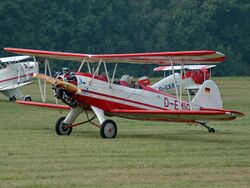Engineering:Focke-Wulf Fw 44 Stieglitz
| Fw 44 Stieglitz | |
|---|---|

| |
| A Focke-Wulf Fw 44J in 2008 | |
| Role | Biplane trainer |
| National origin | Germany |
| Manufacturer | Focke-Wulf |
| Built by | FMA |
| First flight | Late summer 1932[1] |
The Focke-Wulf Fw 44 Stieglitz ("Goldfinch") is a 1930s Germany two-seat biplane. An early design by Kurt Tank,[2] it was produced by the Focke-Wulf company as a pilot training and sports flying aircraft. It was also built under license in several other countries.
Design and development
The Fw 44 was designed as a biplane with conventional layout and straight, untapered wings. Its two open cockpits were arranged in tandem, and both cockpits were equipped with flight controls and instruments. The Fw 44 had fixed tailwheel landing gear. It employed ailerons on both upper and lower wings. It did not use flaps. It was flown with a Siemens-Halske Sh 14 radial engine.
The first prototype flew in 1932.[1] After many tests and modifications to increase the plane's durability and aerodynamics, the final Fw 44 proved to have excellent airworthiness.
A second version of the Fw 44 was the Fw 44B, which had an Argus As 8 four-cylinder inverted inline air-cooled engine of 90 kW (120 hp).[1] The cowling for this engine gave the plane a more slender, aerodynamic nose.
Twenty Fw 44s purchased by China were modified for combat missions, and participated in the early stage of the Second Sino-Japanese War until all were lost in action.
The last series version was the Fw 44J, which was sold or built under license in several countries around the world. It was equipped with a seven-cylinder Siemens-Halske Sh 14 radial engine.
Variants
- Fw 44B
- Fw 44C
- Main production version with minor equipment changes, powered by a seven-cylinder Siemens-Halske Sh 14a radial piston engine.
- Fw 44D
- Fw 44E
- Fw 44F
- Fw 44J
- Final production model, powered by a seven-cylinder Siemens-Halske Sh 14a radial piston engine.
Operators
 Argentina
Argentina
- Argentine Air Force
- Argentine Naval Aviation
The aircraft was produced under license in 1937–1942 period[3]
 Austria
Austria
- Austrian Air Force (1927-1938) – license production
 Bolivia
Bolivia
- Bolivian Air Force – one aircraft was delivered in November 1937[4]
 Brazil
Brazil
- Brazilian Air Force
- Brazilian Naval Aviation
– license production
 Bulgaria
Bulgaria
- Bulgarian Air Force – license production
 Chile
Chile
- Chilean Air Force – 15 aircraft delivered in February 1938[5]
 Colombia
Colombia
 Czechoslovakia
Czechoslovakia
- Czechoslovakian Air Force (Postwar)
 Finland
Finland
 Germany
Germany
- Luftwaffe
 Hungary
Hungary
 Poland
Poland
 Romania
Romania
 Slovakia
Slovakia
 Spain
Spain
 Sweden
Sweden
- Swedish Air Force – license production[6]
 Switzerland
Switzerland
 Turkey
Turkey
- Turkish Air Force (1937–1962)
 Yugoslavia
Yugoslavia
- SFR Yugoslav Air Force – Postwar.
Specifications
Data from Flugzeug Typenbuch 1941 [7]
General characteristics
- Crew: 2
- Length: 7.3 m (23 ft 11 in)
- Wingspan: 9 m (29 ft 6 in)
- Height: 2.7 m (8 ft 10 in)
- Wing area: 20 m2 (220 sq ft)
- Empty weight: 565 kg (1,246 lb)
- Gross weight: 870 kg (1,918 lb)
- Powerplant: 1 × Bramo Sh 14A-4 7-cylinder air-cooled radial piston engine 150 PS (148 hp; 110 kW)
- Propellers: 2-bladed Starrschraube, 2.25 m (7 ft 5 in) diameter fixed-pitch RH rotation wooden propeller
Performance
- Maximum speed: 185 km/h (115 mph, 100 kn)
- Cruise speed: 172 km/h (107 mph, 93 kn)
- Landing speed: 74 km/h (46 mph; 40 kn)
- Range: 675 km (419 mi, 364 nmi)
- Endurance: 4 hours 24 minutes
- Service ceiling: 3,900 m (12,800 ft)
- Rate of climb: 3.4 m/s (670 ft/min)
- Time to altitude:
- 1,000 m (3,300 ft) in 5 minutes 30 seconds
- 3,000 m (9,800 ft) in 23 minutes 36 seconds
- Wing loading: 43.5 kg/m2 (8.9 lb/sq ft)
- Power/mass: 0.1724 PS/kg (0.0771 hp/lb; 0.1268 kW/kg)
- Fuel consumption: .20 L/km (0.071 imp gal/mi)
- Oil consumption: .01 L/km (0.0035 imp gal/mi)
- Take-off distance: 140 m (460 ft)
- Landing distance: 140 m (460 ft)
Notes
- ↑ 1.0 1.1 1.2 Holmes, 2005. p. 79.
- ↑ Munson, K. Fighters Between the Wars 1919-39 1977 p.129 ISBN:071370750X
- ↑ "Focke-Wulf Fw 44 Stieglitz in Detail". http://www.ipmsstockholm.org/magazine/2003/01/stuff_eng_detail_fw44.htm.
- ↑ Focke-Wulf Fw-44J Stieglitz * Retired * Used by the Escuela Militar de Aviación.
- ↑ Focke-Wulf Fw-44 Stieglitz * Retired * Used by the Escuela de Aviación.
- ↑ Plane Encyclopedia Focke-Wulf Fw 44 Stieglitz
- ↑ Schneider, Helmut (1941) (in de). Flugzeug Typenbuch. Leipzig: Herm. Beyer Verlag. p. 68.
Bibliography
- Cortet, Pierre (May 2002). "Rétros du mois" (in fr). Avions: Toute l'Aéronautique et son histoire (110): 4. ISSN 1243-8650.
- Holmes, Tony (2005). Jane's Vintage Aircraft Recognition Guide. London: Harper Collins. ISBN 0-00-719292-4.
Further reading
- Ketley, Barry; Rolfe, Mark (1996). Luftwaffe Fledglings, 1935-1945: Luftwaffe Training Units and Their Aircraft. Hikoki. ISBN 9780951989920. https://books.google.com/books?id=vkgDAAAACAAJ.
- Pavlovcic, Gabriel; Raczynsk, Esteban (4 October 2018) (in es). Focke-Wulf 44J en Argentina. https://www.gacetaeronautica.com/gaceta/wp-101/?p=29436.
External links
- Musee volant de l'Amicale Jean-Baptiste Salis
- Commemorative Air Force
- Biplanes.de's Fw 44 D-EMMI Stieglitz Photo Page (in German)
- YouTube's D-EMMI Stieglitz Takeoff at Eisenhardt airshow in 2010
- Biplanes.de's 85th Anniversary of Focke-Wulf's founding Stieglitz Fly-In Page (in German)
 |




